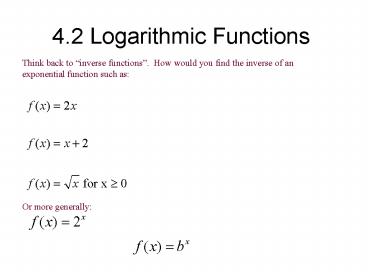4.2 Logarithmic Functions
1 / 17
Title: 4.2 Logarithmic Functions
1
4.2 Logarithmic Functions
Think back to inverse functions. How would you
find the inverse of an exponential function such
as Or more generally
2
Definition of a Logarithmic Function
- For x gt 0 and b gt 0, b 1,
- y logb x is equivalent to by x.
- (Notice that this is the INVERSE of the
exponential function f(x) y bx) - The function f (x) logb x is the logarithmic
function with base b.
3
Location of Base and Exponent in Exponential and
Logarithmic Forms
Logarithmic form y logb x Exponential
Form by x.
To convert from log to exponential form, start
with the base, b, and move clockwise across the
sign b to the y x.
4
Text Example
Write each equation in its equivalent exponential
form. a. 2 log5 x b. 3 logb 64 c. log3 7
y
Solution With the fact that y logb x means by
x,
c. log3 7 y or y log3 7 means
.
5
Evaluate a. log2 16 b. log3 9 c. log25
5
Solution
6
Basic Logarithmic Properties Involving One
- logb b because ____is the exponent to which b
must be raised to obtain b. - (b__ b).
- logb 1 because ____ is the exponent to which b
must be raised to obtain 1. - (b__ 1).
7
Inverse Properties of Logarithms
- For bgt0 and b ? 1,
- logb bx x The logarithm with base b of b
raised to a power equals that power. - b logb x x b raised to the logarithm with
base b of a number equals that number. - That is since logarithmic and exponential
functions are inverse functions, if they have the
SAME BASE they cancel each other out.
8
Properties of Logarithms
- General Properties Common Logarithms
- 1. logb 1 0 1. log 1 0
- 2. logb b 1 2. log 10 1
- 3. logb bx x 3. log 10x x
- 4. b logb x x 4. 10 log x x
- If no base is written for a log, base 10 is
assumed. If it says ln, that means the natural
log and the base is understood to be e.
Natural Logarithms 1. ln 1 0 2. ln e 1 3. ln
ex x 4. e ln x x
9
Ex
- log 4 4
- log 8 1
- 3 log 3 6
- log 5 5 3
- 2 log 2 7
ln e ln 1 e ln 6 ln e 3
10
Text Example
Graph f (x) 2x and g(x) log2 x in the same
rectangular coordinate system.
Solution We first set up a table of coordinates
for f (x) 2x. Reversing these coordinates gives
the coordinates for the inverse function, g(x)
log2 x.
Reverse coordinates.
11
Continued
Graph f (x) 2x and g(x) log2 x in the same
rectangular coordinate system.
Solution
We now plot the ordered pairs in both tables,
connecting them with smooth curves. The graph of
the inverse can also be drawn by reflecting the
graph of f (x) 2x over the line y x.
Where is the asymptote for the exponential
function, where is it now for the log
function? What happened to the exponential
functions y-intercept?
12
Characteristics of the Graphs of Logarithmic
Functions of the Form f(x) logbx
- The x-intercept is 1. There is no y-intercept.
- The y-axis is a vertical asymptote.
- If b gt 1, the function is increasing. If 0 lt b lt
1, the function is decreasing. - The graph is smooth and continuous. It has no
sharp corners or edges.
13
Log Graphs using Transformations
- shift c up cgt0
- shift c down clt0
- shift c right cgt0
- shift c left clt0
- reflect about y-axis
- reflect about x-axis
14
- Also do p 421 18, 64, 78, 82, 102, if time 119
- 18. Write in equivalent log form
15
- 64. Graph f(x) logx, then use transformations
to graph g(x) 2-logx. Find the asymptote(s),
domain, range, and x- and y- intercepts.
16
- 78. Find the domain of f(x) log (7-x)
- 82. Evaluate without a calculator log 1000.
17
- 102. Write in exponential form and solve































